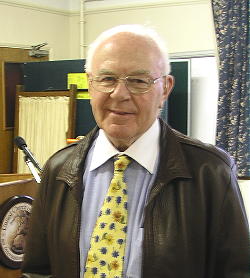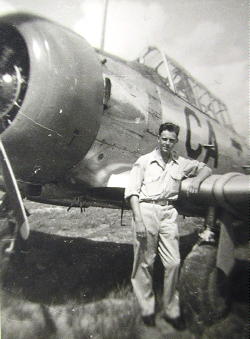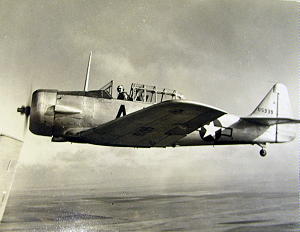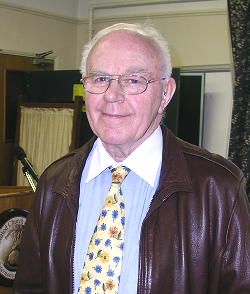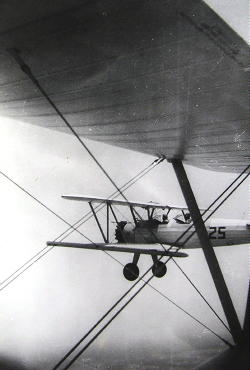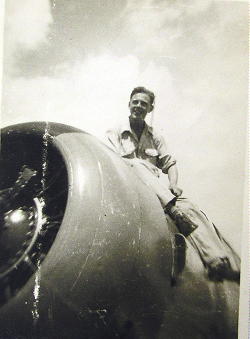The death of Donald Norman Beard occurred on May 13th 2005
|
|
On March 12, 2005 I attended Church in Watford, Herts. I was in the United Kingdom to visit Peter Hawkins and attend a board meeting. In services I had a wonderful conversation with member Don Beard who spoke of his World War II experiences. He happened to have an envelope of photos with him that I photographed on the spot that are included at the end of this file. I told him that I was looking forward to a written remembrance of his war days...maybe it would be something of interest that could be shared with others on my website.
Two months later Don Beard suddenly died. What a sad day! I was left with the memory of a fascinating conversation, but nothing more than a few photos. But, in conversation with elder Will McLouglin of Bricket Wood, I was assured to have some of his remembrances.

Don was eighty one years young and a much loved member of our Bricket Wood congregation. Don was young at heart and had a great sense of humour, he remained active till the end and looked forward to the weekly service and fellowship with the brethren, he was a true gentleman offering a kind word of encouragement wherever he could. Don remained awed at the privilege of his calling and never ceased to wonder at the creation, enjoying it’s many facets, he loved the garden with it’s plants and visiting wildlife and was quick to come to the aid of anything in trouble, e.g., a weary bee in need of some honey.
After retirement Don travelled to different parts of the world and often talked of these exciting experiences and the meeting of like-minded people, there was also another momentous time in Don’s life and that was during the second world war when he was called into the airforce and sent abroad for pilot training, it made a lasting impression!
He talked about it often and after being encouraged to write about it, finally made a start. Unfortunately he died before getting much written yet his ability to paint a picture with words comes across and is an interesting if brief insight to one young man’s thoughts on life’s exciting adventure.
RECOLLECTIONS BY DON BEARD.
The place was Riddle Field and the time (for me) was April 1945. Where you may ask is Riddle Field? Well, at the time in question it was an airfield near to Lake Okeechobee in Southern Florida and about nine miles from the town of Clewiston.
 At this airfield, No 5 B.F.T.S. - British Flying Training School were Royal Air Force cadets; there for the express purpose of learning to fly. How was it then that these British airmen were in the United States being taught to fly, and by American instructors?
At this airfield, No 5 B.F.T.S. - British Flying Training School were Royal Air Force cadets; there for the express purpose of learning to fly. How was it then that these British airmen were in the United States being taught to fly, and by American instructors?
In 1940 Britain had it’s back to the wall, for the German army and air force had over-run Europe and now stood just over twenty miles from the White Cliffs of Dover; the birds were not blue and had large black crosses on them! Hundreds of German aircraft attacked Britain throughout the glorious summer of 1940. I know because I saw some of it from my home town of Margate in East Kent.
During the day in 1940 large numbers of German aircraft could be seen crossing the coast to targets further inland and night after night the sound of Dorniers and Heinkels tracking one after the other on their way to London; the sound of one barely off the air when the next one could be heard approaching from it’s base in Northern France. There was no need to count sheep!
But I digress. It was then, a desperate situation and Winston Churchill appealed to the United States for assistance in the form of war materials and pilot training facilities. Thus was born the "Lend Lease Act" brought in the President Roosevelt and as part of this the British Flying Training Schools were constructed in Arizona, Florida, Texas, Oklahoma and California.
The normal weather being so often what it is in Britain, i.e. inclement and unreliable, is not the best for flying training, not in comparison with that which can be found in the southern states of the United States.
My adventure – this particular adventure began when I received a telegram at my home in Margate to return from leave to Heaton Park. This park was being used as a huge transit camp for R.A.F. personnel and was in Manchester. The next exciting thing was to find myself standing on the deck of the Queen of the Atlantic: the Queen Mary. All around were the brightly sunlit hills of Greenock bay with lots of nautical activity going on all around.
I was allocated picquet duty for the crossing. Much of the boat deck was covered in and had dimly lit blue lighting. When one, at three o’clock in the morning, passed through the dividing door on to the open section of the boat deck at the stern of the ship, there above were glowing the star studded heavens whilst streaming into the distance was the phosphorescent wake of the ship as her throbbing engines drove her steadily onwards to the United States. It was difficult to tear oneself away from the scene in the realization that this was a unique experience, unlikely to ever present itself again. I stood there in awe for a long time.
Having been transported across the Atlantic on the Queen Mary together with many wounded American servicemen returning from the European theatre of war, we arrived to an icy New York on 10th March 1945. The U.S. troops received an enthusiastic welcome from brass bands playing from the decks of steamers circling the great ship. Playing on a bitterly cold morning, bright, cheerful and stirring Souza music. What a welcome, even if not for us! We’d arrived in the good old U.S. of A.
R.A.F. personnel entrained and went through snow covered countryside to Moncton to an R.C.A.F. transit camp in New Brunswick. A couple of weeks later we were off again to our respective flying training schools in the southern United States. I was delighted to have been able to attach myself to the contingent going to No.5 B.F.T.S. in Florida.
The train journey was an adventure in itself – Grand Central Station – what a magnificent building – Cathedral like. Then as the train rolled further and further into the south from the darkened railway coach one could see glimpses of reflected moonlight off bayoux silhouetting – what was it? Why swamp grass hanging in festoons from trees! And are those winking lights or are my eyes
 playing tricks? Why fireflies I guess! How wonderful. Blacked out Britain seemed a long way away.
playing tricks? Why fireflies I guess! How wonderful. Blacked out Britain seemed a long way away.
At Jacksonville or was it Sebring the goodly citizens sent aboard sacks of oranges. An item which had disappeared from greengrocer’s stalls in Britain throughout the war.
Riddle Field was on the left of the long straight road out of Clewiston and the airfield seemed huge. The first entry in my Pilots Flying Log Book is 5th April 1945 with
Mr E.A. Macleod as 1st Pilot (instructor) and I (pupil). The aircraft was a P.T.13D;
a Diplare and a Primary Trainer as signified by the initials P.T.
It’s familiar or popular name is Steerman. A very sturdy aircraft. This then was the Primary Course of 75 hours. There were a further two courses each of 70 hours duration: Mid advanced and advanced. A total altogether of 210 hours. The two latter courses were in the AT6D – the AT signifying Advanced Trainer. This all metal aircraft had flaps, retractable undercarriage, hood, etc., It was a strong aircraft, some of which are still flying today. It’s popular name is the Harvard. It has a 650hp Pratt and Witney engine which was indeed very noisy if not to say deafening. These 210 hours of training were a combination of dual and solo flying training to bring us air cadets into familiarity with all aspects of flying and to receive at the end of it the much coveted pilots wings. Unfortunately, or should it be fortunately, the war came to an end and none of us graduated because understandably, there was no further need for pilots.
What a waste one might say and true, but I had been a year waiting to get on course as had the rest of the cadets.
Below are photos that Don Beard held in hand and I was able to photograph with my camera.
|
Another photo on March 12, 2006 |
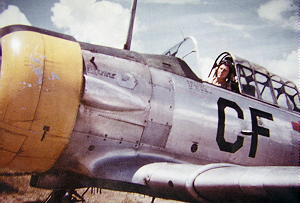
|
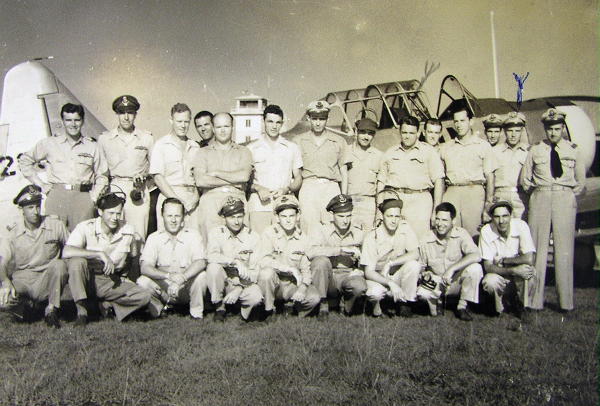
Don Beard is in the back row....2nd from the far right.....blue mark above his head.
